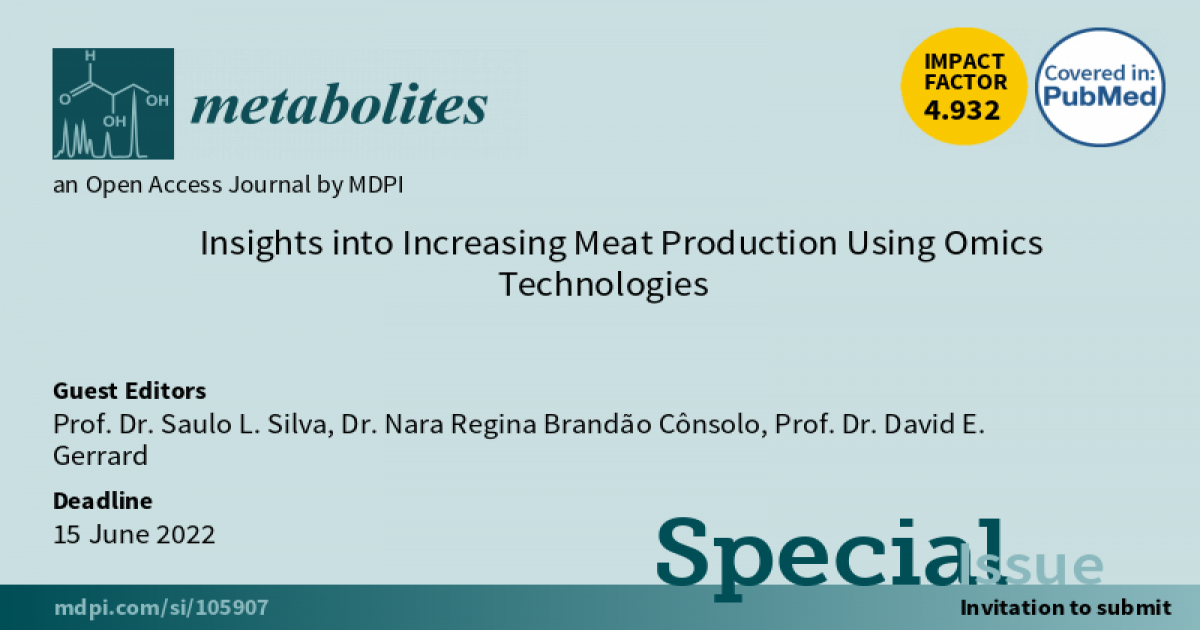Insights into Increasing Meat Production Using Omics Technologies
A special issue of Metabolites (ISSN 2218-1989). This special issue belongs to the section "Animal Metabolism".
Deadline for manuscript submissions: closed (15 June 2022) | Viewed by 18460

Special Issue Editors
Interests: animal growth; food composition; meat quality; muscle biology
Interests: NMR-based metabolomics; meat quality; animal metabolism; animal production
Interests: muscle; metabolism; fiber type; biochemistry; mitochondria; nutrition; energy
Special Issues, Collections and Topics in MDPI journals
Special Issue Information
Dear Colleagues,
Meat animal production systems are constantly being challenged to improve the quantity and quality of products to satisfy consumers’ ever-growing appetite for more and better products—all while demanding a reduction in the use of valuable inputs and limiting impacts on the environment. To accomplish this lofty goal, the creation of new knowledge about muscle growth and meat quality development is absolutely essential if we are to realize gains necessary for feeding the burgeon global population by 2050. A systems-biology approach to studying animal production is a strategy for understanding the complexity of a myriad of biochemical and molecular mechanisms that change in the process of growing tissues that ultimately culminate into a highly nutritious and satiating food: meat. Factors include but are not restricted to feeding regime, genetics, stress, rearing environments, and harvesting and maturation conditions. Understanding the nature of these complex relationships and those variables that impinge on the process of producing high-quality lean meat need to be further understood if significant advances are to be realized in the future. In this regard, a muscle omics-based approach holds great potential to unravel the biochemical changes that occur in this valuable commodity during its production and maturation into meat. Therefore, this Special Issue aims to cover production animal livestock metabolomics and the integration with multi-omics to explore the complex interactions among various factors that impact animal performance and the quality of products produced from agronomically relevant species.
This Special Issue will also address sample preparation methods, advances in data processing, optimization for targeted and untargeted analysis, statistical data analysis using different platforms, and new frontiers and technological breakthroughs fostered by omics technologies. We strongly encourage the submission of research based on metabolic processes and networks, and on the integration with multi-omics and biomarkers discovery.
For this Special Issue of Metabolites, we invite original research papers and reviews that advance our knowledge and understanding of the complex processes that affect livestock biological systems, using varied omics approaches. We hope this Special Issue will contribute to the cutting-edge knowledge undergirding the production of high-quality food products from livestock.
We look forward to your contributions.
Prof. Dr. Saulo L. Silva
Dr. Nara Regina Brandão Cônsolo
Prof. Dr. David E. Gerrard
Guest Editors
Manuscript Submission Information
Manuscripts should be submitted online at www.mdpi.com by registering and logging in to this website. Once you are registered, click here to go to the submission form. Manuscripts can be submitted until the deadline. All submissions that pass pre-check are peer-reviewed. Accepted papers will be published continuously in the journal (as soon as accepted) and will be listed together on the special issue website. Research articles, review articles as well as short communications are invited. For planned papers, a title and short abstract (about 100 words) can be sent to the Editorial Office for announcement on this website.
Submitted manuscripts should not have been published previously, nor be under consideration for publication elsewhere (except conference proceedings papers). All manuscripts are thoroughly refereed through a single-blind peer-review process. A guide for authors and other relevant information for submission of manuscripts is available on the Instructions for Authors page. Metabolites is an international peer-reviewed open access monthly journal published by MDPI.
Please visit the Instructions for Authors page before submitting a manuscript. The Article Processing Charge (APC) for publication in this open access journal is 2700 CHF (Swiss Francs). Submitted papers should be well formatted and use good English. Authors may use MDPI's English editing service prior to publication or during author revisions.
Keywords
- animal products
- biomarkers
- livestock
- lipidomics
- muscle metabolism
- metabolites
- metabolomics
- proteomics
- transcriptomics
Benefits of Publishing in a Special Issue
- Ease of navigation: Grouping papers by topic helps scholars navigate broad scope journals more efficiently.
- Greater discoverability: Special Issues support the reach and impact of scientific research. Articles in Special Issues are more discoverable and cited more frequently.
- Expansion of research network: Special Issues facilitate connections among authors, fostering scientific collaborations.
- External promotion: Articles in Special Issues are often promoted through the journal's social media, increasing their visibility.
- e-Book format: Special Issues with more than 10 articles can be published as dedicated e-books, ensuring wide and rapid dissemination.
Further information on MDPI's Special Issue polices can be found here.








